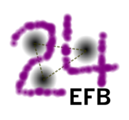A review of the main applications of the Trojan Horse Method (THM) will be presented, focusing on reactions involving few-body systems. This indirect method exploits nuclei clustering properties to measure cross sections otherwise very difficult to get.
The THM has been applied to the sub-Coulomb proton-proton elastic scattering to investigate the suppression of the Coulomb field effects and...
In our work we have studied ${}^9{\rm Be}$ ground state with non-local $\alpha n$ and $\alpha\alpha$ potentials derived from Cluster Effective Field Theory. The Borromean system provided by the nucleus of ${}^9{\rm Be}$ shows, at low energy ($<\,20\,$MeV), a separation of scales and the dynamics describing the cluster configuration is insensitive to internal dynamics of the $\alpha$ particle....
A method has been recently proposed on Phys.Rev. C 99 (2019) 031302 to establish the geometry of the alpha-cluster arrangement in 12C making use of polarized gamma-rays. The ratio of intensities of scattered radiation at 90 degree along and perpendicular to the initial direction of the electric field vector, called depolarization ratio, is a key quantity that allows to underpin the nature of...
Recent advances in radioactive ion beam physics and detection techniques have triggered the exploration of the exotic properties and decay modes of light nuclear systems at the limit of stability and beyond the driplines. Large experimental and theoretical efforts have been devoted to understanding the structure and reaction dynamics of loosely bound systems, such as halo nuclei, where...

